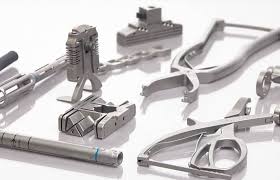Machining Medical Parts: Precision Engineering for Enhanced Healthcare

In the intricate world of modern healthcare, the manufacturing of medical parts through precision machining plays a pivotal role in delivering high-quality medical devices and equipment. This article explores the significance of machining medical parts, the advanced techniques involved, and the impact of precision engineering on healthcare outcomes.
Understanding Machining Medical Parts
Machining medical parts involves the process of shaping, cutting, and finishing components to precise specifications required for medical devices and equipment. This precision engineering is essential to ensure the functionality, durability, and safety of medical tools used in diagnostics, treatment, and patient care. Key aspects of machining medical parts include:
- Computer Numerical Control (CNC) Machining: CNC machining is a fundamental technique used in the production of medical parts. It utilizes computer-controlled machines to remove material from a workpiece, resulting in components with accurate dimensions and complex geometries. CNC machining ensures consistency and repeatability in manufacturing medical devices.
- Micro-Machining: Micro-machining techniques are employed for producing extremely small and intricate medical components. This includes processes such as micro-milling, laser machining, and EDM (Electrical Discharge Machining), which are crucial for manufacturing microsurgical instruments, implantable devices, and miniature medical components.
- Additive Manufacturing (3D Printing): Additive manufacturing has emerged as a revolutionary technique for machining medical parts, especially for prototyping and creating patient-specific components. 3D printing enables the production of complex geometries, customization, and rapid manufacturing of medical implants, prosthetics, and surgical guides.
- Precision Injection Molding: Injection molding is utilized for mass-producing plastic and polymer medical parts with high precision and repeatability. It is commonly used for manufacturing housings, connectors, and disposable components for medical devices.
Applications of Machining Medical Parts
The machining of medical parts finds extensive applications across various domains within healthcare, including:
- Surgical Instruments: Machined medical parts are integral to the manufacturing of surgical instruments such as scalpels, forceps, retractors, and laparoscopic tools. These instruments require exceptional precision to ensure optimal performance, reliability, and patient safety during surgical procedures.
- Implantable Devices: Components fabricated through machining are essential for implantable medical devices like orthopedic implants, cardiovascular stents, and dental prosthetics. These components must meet stringent biocompatibility standards, precise dimensions, and surface finishes to ensure successful integration and long-term functionality within the human body.
- Diagnostic Equipment: Precision machining plays a vital role in diagnostic equipment such as imaging systems (MRI, CT scanners, ultrasound machines), laboratory analyzers, and point-of-care testing devices. Machined parts enable accurate measurements, imaging, and data acquisition, contributing to precise diagnostics and improved patient care.
- Drug Delivery Systems: Machining medical parts is crucial for producing components used in drug delivery systems such as infusion pumps, inhalers, and insulin pens. These systems require precise dosing mechanisms, fluid handling components, and patient-friendly designs for effective drug delivery and management of medical conditions.
Impact on Healthcare Advancements
The integration of machining medical parts has a profound impact on advancing healthcare technologies and improving patient outcomes:
- Minimally Invasive Procedures: Precision-crafted instruments and devices enable minimally invasive surgeries, reducing patient trauma, recovery times, and hospital stays while improving surgical outcomes and patient satisfaction.
- Customization and Personalization: Machining medical parts facilitates the customization and personalization of medical devices, implants, and prosthetics based on patient-specific requirements. This customization leads to enhanced comfort, functionality, and better patient outcomes.
- Diagnostic Accuracy: Machined components in diagnostic equipment contribute to improved imaging quality, measurement accuracy, and diagnostic capabilities, enabling healthcare professionals to make accurate diagnoses and treatment decisions.
- Quality and Reliability: The exceptional quality and reliability of machined medical parts ensure the safety, efficacy, and longevity of medical devices, supporting optimal performance throughout their lifespan and enhancing patient safety.
Future Trends and Innovations
Looking ahead, several trends and innovations are shaping the future of machining medical parts:
- Advanced Materials: The development of new materials with enhanced properties such as biocompatibility, durability, and antimicrobial surfaces will drive innovation in machining medical parts for diverse medical applications.
- Robotics and Automation: The integration of robotics and automation in machining processes will enhance productivity, reduce lead times, and ensure consistent quality in manufacturing medical devices and components.
- Digital Twin Technology: Digital twin technology enables virtual simulations, optimization of machining processes, and predictive maintenance, leading to faster prototyping, improved designs, and reduced time-to-market for medical parts.
- Smart Manufacturing: The adoption of smart manufacturing technologies such as IoT (Internet of Things), AI (Artificial Intelligence), and data analytics will enable real-time monitoring, quality control, and optimization of machining processes in medical device manufacturing.
In conclusion, machining medical parts through precision engineering is essential for advancing healthcare technologies, improving patient care, and driving innovation in medical device manufacturing. With ongoing advancements in machining techniques, materials science, and digital integration, the future of machining medical parts holds tremendous potential for shaping the next generation of healthcare solutions and enhancing the quality of life for patients worldwide.




